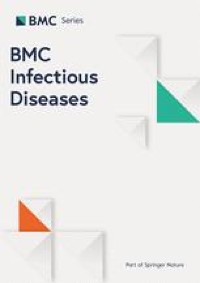Acremonium (Sarocladium) periprosthetic joint infection: case report ... - BMC Infectious Diseases

Fungal periprosthetic joint infections (PJIs) have been reported to comprise only 1–3% of all joint infections, the majority of which are attributed to Candida and Aspergillus species [1]. Also, it is widely accepted that fungal infections are a hallmark illness of immunocompromised patients. However, it has been reported that nearly 40% of fungal osteoarticular infections are in apparently immunocompetent patients [5]. As with any unusual pathogen, cases should be reviewed for commonalities from services provided during the care of the patient to ensure no potential for epidemiological linkage within the healthcare system. No other causative factor was delineated in our case other than her traumatic fall ten years prior to her presentation. The occult infection dwelled over many years and destroyed the bone to the point where it could not support the prosthesis and subsequently led to component failure. Interim replacement without identifying the infection resulted in repeat failure of the new prosthesis in diseased bone. Reviewing prior orthopedic cases at our institution that involved culture findings with Acremonium, most have been ruled as a contaminant based on the scarcity of fungal growth (i.e., fungal growth in only one out of several cultures) and lack of other symptoms, signs, and laboratory evidence of active infection.
The diagnosis of a PJI relies on a combination of clinical presentation, laboratory data, and intraoperative findings [6]. This includes visualization of a communicating sinus tract or purulence, a pathogen isolated by culture from at least two separate tissue or fluid samples, and histopathologic inflammation of periprosthetic tissue. Efforts have been made to introduce preoperative diagnostic criteria improving one's pretest probability with the inclusion of serum inflammatory markers and synovial fluid analysis [7]. These weighted minor criteria propose a likelihood of infection. Acremonium isolates can be difficult to identify when solely using morphological methods. To further define the isolate, molecular confirmation via sequencing of the internal transcribed spacer (ITS) fungal barcode and the actin gene can be performed. However, speciation is not routinely done in the clinical microbiology laboratory. Two species, Acremonium kiliense (now Sarocladium kiliense) and Acremonium egyptiacum, have been proven to be involved in human infections [8]. Although it was not thought to be clinically important at the time, identification of the species would have been an opportunity to align our isolate with one of these known pathogens.
Acremonium is an uncommon human pathogen. Acremonium osteoarticular infections are reported even less so in the literature. In a review of 61 fungal osteoarticular infections, Acremonium was noted in 3 cases, none of which involved prosthetic joints [9]. A combination of surgery and antifungals is imperative to provide the patient with best chance of success. After surgical revision, an extended course of antifungals is recommended. For Candida and Aspergillus PJIs, this can range from 3 to 6 months depending on the host response. Wu et al. described, to the best of our knowledge, the first PJI involving Acremonium along with Penicillium. The patient in the study had their hardware removed and was placed on fluconazole for 12 months [10]. It was shown previously that the most effective agents for Acremonium based on the minimum inhibitory concentration (MIC) and the minimum fungicidal concentration (MFC) were amphotericin B, itraconazole, and ketoconazole [11]. More recently, Perdomo et al. reported that terbinafine, posaconazole, and amphotericin B were the most effective, but variable susceptibility makes it difficult to choose the optimal antifungal agent [2]. Since there are no standardized MIC breakpoints for Acremonium, it was particularly important to choose an agent with commercially available monitoring methods while susceptibility testing was pending. For our patient, we empirically started voriconazole based on reported cases of its use for Acremonium infections in different body sites and known bioavailability in bone and synovial fluid [12]. Also, serum voriconazole concentrations can be monitored for dose adjustments. A relatively low MIC to voriconazole has been reported (0.25 µg/mL), at which 90% of Acremonium isolates were inhibited [13]. In previous studies, achieving a voriconazole trough concentration of > 1 µg/mL has shown improved outcomes for susceptible organisms but a concentration of < 0.25 µg/mL has a higher probability of treatment failure [14]. Toxicity—manifested by visual disturbances (photopsia), liver dysfunction, skin reaction, and neurotoxicity (confusion and visual hallucinations)—is usually not noted until the concentration reaches levels of 4–6 µg/mL [14]. Optimal trough levels for efficacy have yet to be established. Our Acremonium MIC to voriconazole was 1.0 µg/mL. Our patient's initial trough concentrations were < 0.5 µg/mL but brought to 1.0–1.5 µg/mL with dose adjustment, leading to treatment success.
Acremonium is becoming recognized as an emerging pathogen. Fungal PJI is rare, more so with Acremonium, and a high index of suspicion and familiarity with diagnostic criteria are key to recognizing it. While it may often be dismissed, our case shows that Acremonium grew in multiple cultures: synovial fluid, hardware sonicate, and bone. This puts forward robust evidence for a genuine fungal infection. The choice of an antifungal regimen has not been well established for prosthetic joint infection. We have presented a relatively safe and effective antifungal agent which can be used as a long-term therapy. As there is only one other report of Acremonium PJI, there is limited data with which to compare. With variable susceptibility testing in reported isolates, individualized antifungal susceptibility should be used to guide therapy for Acremonium infections [2, 11]. The source of this infection for our patient remains unclear.
Comments
Post a Comment